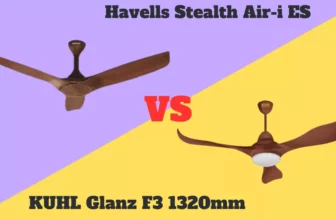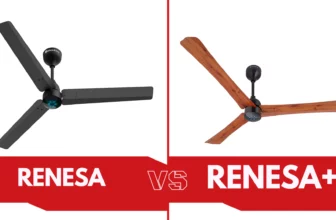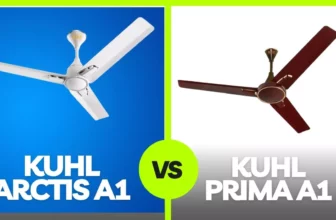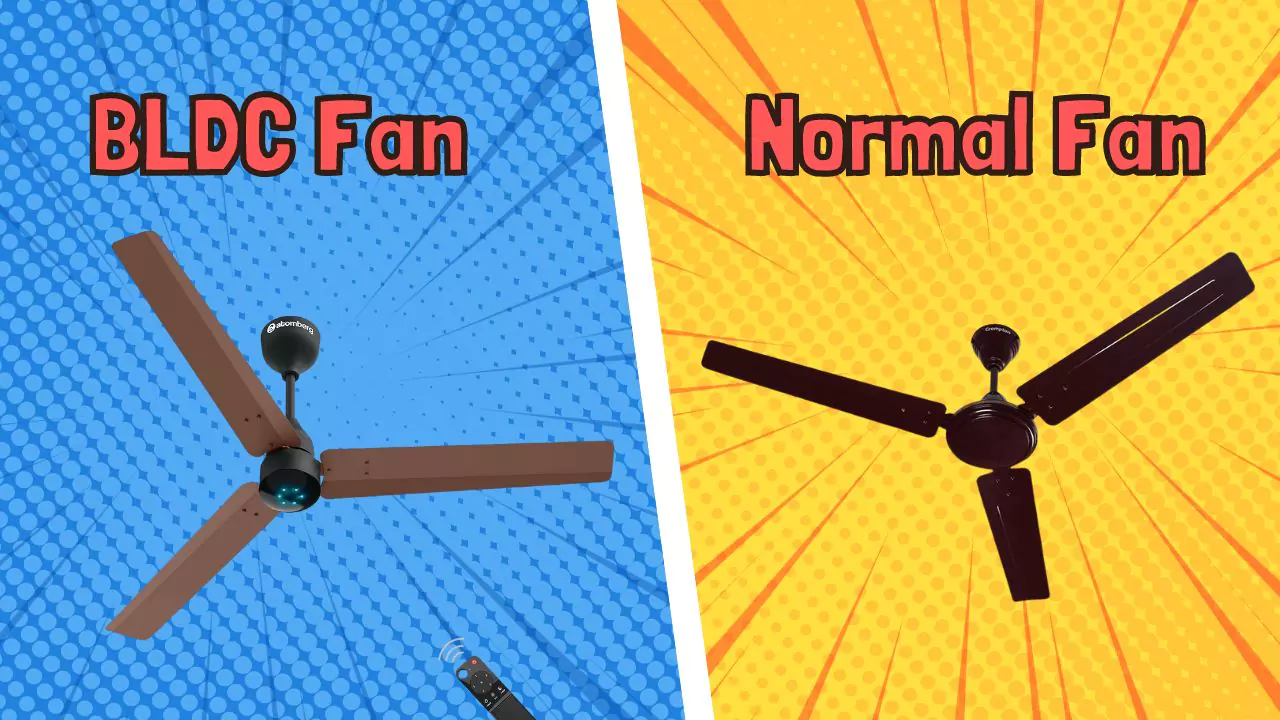
There are two types of ceiling fans available in India: the normal fan, which is equipped with an induction motor, and the BLDC fan, which is equipped with a brushless direct current (BLDC) motor. Both have their own pros and cons, and they differ in their features, performances, and, of course, price ranges.
For the time being, the BLDC fans have become so popular and are so efficient. Also, modern ceiling fans feature smart technology as well as an appealing aesthetic design. Not only BLDC fans but also standard induction ceiling fans are available with long-lasting durability and appealing designs. People are considering energy-efficient ceiling fans because they consume 50 to 60 percent of the power consumed by ceiling fans because they run continuously and nonstop, and normal ceiling fans consume twice the power of a BLDC motorized fan. So let’s be clear about this.
BLDC Fan vs Normal Fan
Design: While there’s no significant difference in design, the BLDC motor’s lighter weight stands out due to technological advancements. Additionally, most BLDC fans feature modern designs with LED light options, setting them apart from traditional (Normal) fans.
Motor: The major difference between normal and BLDC fans lies in the motor efficiency. The BLDC motor outperforms in all aspects, showcasing higher efficiency compared to traditional fan motors.
Controller: Most BLDC fans come with a remote controller. Some BLDC fans also offer the option of normal regulator control, similar to traditional fans.
Energy Consumption: This stands as a key differentiator. The BLDC motor consumes significantly less power than traditional fans. For instance, while a normal fan may use 75W to operate, a BLDC fan requires only 28W for operation, demonstrating far better energy efficiency.
Smart Features: While normal fans now incorporate IoT features, BLDC fans offer a broader range of options in this segment. They provide control through apps, IR, Wi-Fi, Bluetooth, and even voice assistants, offering users enhanced convenience.
Air Delivery: Due to technological advancements, BLDC fans deliver higher airflow measured in cubic meters per minute (CMM), surpassing the air delivery of traditional fans.
Speed: Thanks to reduced friction technology, BLDC fans provide higher speeds compared to traditional fans, offering a more efficient airflow experience.
Technology
Let’s know what BLDC technology and induction motor technology are!
People search for what is BLDC motor technology and how BLDC fan technology differs from a normal fan, so let’s look at the differences between the two below.
BLDC Motor Fan Technology
The BLDC motor is based on brushless DC technology, which significantly reduces friction by enabling a continuous electricity connection. At the core of the BLDC motor lies a permanent magnet, allowing it to deliver more power while consuming less energy.
The BLDC (Brushless Direct Current) motor technology is a type of electric motor that operates using a permanent magnet rotor and a stator with windings. Unlike conventional brushed motors that use brushes to make physical contact with the commutator, BLDC motors employ electronic commutation to control the phase currents of the stator windings. This method eliminates the need for brushes, reducing friction, noise, and wear, resulting in higher efficiency and longevity.
BLDC motors find extensive applications in various industries, including appliances, automotive systems, aerospace, and robotics, due to their reliability, high efficiency, precise speed control, and lower maintenance requirements.
it has an electronic circuit board that has been programmed to provide more speed options (5 or more) and to control the fan’s operation via remote control, which is not possible with a normal fan. Because of its advanced motor technology, the BLDC fan’s motor runs quietly and produces a smooth airflow. BLDC fans are also more energy efficient than normal fans due to this motor technology.
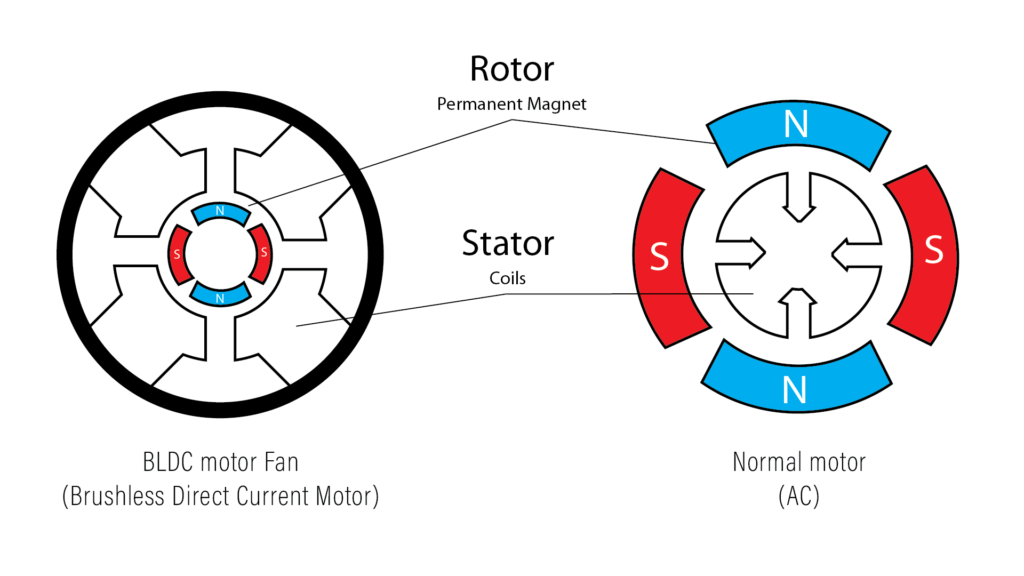
Advantages of being a BLDC fan:
- High durability and longevity with a BLDC fan.
- Super silent operation.
- Improve the reliability quotient with BLDC fans.
- BLDC fan can control with a remote.
- They are much more power efficient.
- longer backup on inverters.
- They come with an inbuilt stabilizer.
Normal Ceiling Fan Technology
Normal fans consist of an induction motor, which is also called an induction motor ceiling fan. A normal ceiling fan uses an induction motor to rotate the fan blades. The motor assembled a stator with coils and a rotor with a set of copper windings. When electric power is supplied to the stator coils, they create a magnetic field that induces a current in the rotor windings. This current creates a second magnetic field, which interacts with the magnetic field of the stator, causing the rotor to rotate. This is a very old, certified, and trusted motor mechanism; most heavy motors use this one.
The motor is connected to a power source and controlled by a regulator, and it typically has three-speed settings that the user can switch manually. The motor of the normal fan produces more noise compared to the BLDC fan due to the mechanical contact between the motor and the fan blades. Normal fans consume more power compared to BLDC fans and are less energy-efficient.
Difference between a BLDC fan and a normal fan
BLDC Fans:
- BLDC stands for Brushless DC motor, which means they have a motor that uses permanent magnets to rotate the fan blades.
- They consume less power compared to normal fans and are more energy-efficient.
- They operate silently and provide smooth airflow due to their advanced motor technology.
- They come with more speed options (5 or more) and remote control operation.
- They are more expensive compared to normal fans.
Normal Fans:
- They use an induction motor to rotate the fan blades.
- They consume more power compared to BLDC fans and are less energy-efficient.
- They produce more noise during operation compared to BLDC fans.
- They typically come with 3-speed options and manual control.
- They are budget-friendly compared to BLDC fans.
Lastly, BLDC fans are more advanced, energy-efficient, convenient to use, and quieter compared to normal fans, but they are also more expensive.
BLDC Fan vs Normal Fan (Feature Comparison)
| Features | BLDC Fan | Normal Fan |
|---|---|---|
| Energy Efficient | Yes | No |
| Silent Operation | Yes | No |
| Inbuilt Stabilizer | Yes | No |
| Wattage | 28w to 40w | 65w to 80w |
| Inverter-Friendly | Yes | No |
| IOT-Enabled | Yes(some models) | No |
| Higher Speed | Yes | No |
| Regulator | No need | Yes |
| Capacitor | No need | Yes |
| Remotely Controlled | Yes | No |
| Power Consumption | Lower | Higher |
| RPM | Higher | Lower |
| Reverse Rotation | Yes (In some models) | No |
| Price Range | Higher | Lower |
BLDC Fan vs Normal Fan Power Consumption
| Feature | BLDC fan | Normal fan |
|---|---|---|
| Wattage | 35 | 75 |
| Daily Hours | 16 | 16 |
| Hourly Consumption | 0.035 units | 0.075 units |
| Daily Consumption | 0.56 units | 1.2 units |
| Yearly Consumption | 204.4 units | 438 units |
| Yearly Costs (assuming Rs 9 per unit) | Rs 1839.6 | Rs 3942 |
Note: The comparison took on standard wattage and Madhyapradesh unit rate (up to 100 unit rs 9, above 100 unit price rs 12 in Madhya Pradesh)
Comparing Energy Consumption
Comparing power consumption, BLDC fans typically consume 50-60% less power than traditional fans. For instance:
- BLDC Fan: Wattage – 35W; Yearly Costs (assuming Rs 9 per unit): Rs 1839.6
- Normal Fan: Wattage – 75W; Yearly Costs (assuming Rs 9 per unit): Rs 3942
Realizing the Environmental Impact
Choosing an energy-efficient fan not only leads to cost savings but also contributes to a reduced carbon footprint. BLDC fans, due to their lower energy consumption, are more environmentally friendly.
Factors to Consider
Factors like initial investment, long-term savings, noise reduction, and environmental impact should guide your choice between BLDC and traditional fans. While BLDC fans offer advanced technology and energy efficiency, traditional fans remain an affordable and trusted choice.
Conclusion
BLDC fans undoubtedly offer technological advancements and energy savings, albeit at a higher initial cost. Traditional fans, while less energy-efficient, remain a reliable and cost-effective choice. Understanding your priorities—be it energy savings, convenience, or affordability will aid in making the right choice for your home.




